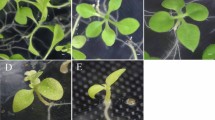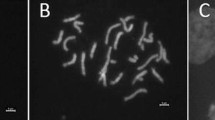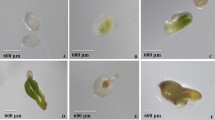Abstract
Interspecific hybrids from crosses between H. syriacus × H. paramutabilis and H. syriacus × H. sinosyriacus were obtained. In both cases unilateral incongruity was observed and reciprocal crosses yielded no fruits. In vitro embryo rescue, 11 weeks after pollination, increased the germination capacity of H. syriacus × H. sinosyriacus embryos, while this was not the case for H. syriacus × H. paramutabilis embryos. However, a lot of the generated H. syriacus × H. sinosyriacus seedlings were lost due to variegated and total albinism. In the progeny of H. syriacus ‘Oiseau Bleu’ × H. paramutabilis about 95% of the seedlings had an intermediate flower and leaf morphology compared to both parent plants. Leaves on the adult F1 hybrids showed a polymorphism. In total four different leaf types could be observed on the same plant. This leaf polymorphism also was seen in the progeny of H. syriacus ‘Melwhite’ × H. sinosyriacus ‘Lilac Queen’. In this progeny about 50% of the seedlings had an intermediate flower and leaf morphology compared with the parent plants. The hybrid nature of the seedlings of both progenies was also confirmed by AFLP analysis. Despite the low germination vigour of the pollen of the hybrids, a small F2 generation was obtained from H. syriacus ‘Oiseau Bleu’ × H. paramutabilis.




Similar content being viewed by others
References
Bates DM (1965) Notes on the cultivated Malvaceae. 1. Hibiscus. Baileya 13:57–130
Bean WJ (1973) Trees and shrubs hardy in the British isles (8th edition revised volume II). John Murray, London, UK
Buitendijk JH, Ramanna MS, Jacobsen E (1992) Micropropagation ability: towards a selection criteria in Alstroemeria breeding. Acta Hortic 325:493–498
Critchfield WB (1960) Leaf dimorphism in Populus trichocarpa. Am J Bot 47:699–711
Doyle J, Doyle J (1987) Genomic plant DNA preparation from fresh tissue - CTAB method. Phytochem Bull 19:11
Eeckhaut T, Van Laere K, De Riek J, Van Huylenbroeck J (2006) Overcoming interspecific barriers in ornamental plant breeding. In: Taxeira da Silva JA (ed) Floriculture, ornamental and plant biotechnology: advances and topical issues, 1st edn. Global Science Books, London, UK. pp 540–551
Egolf DR (1971) Hibicsus syriacus ‘Diana’ a new cultivar (Malvaceae). Baileya 17:75–78
Egolf DR (1981) Meet ‘Helene’ a new Hibiscus syriacus. Am. Nurseryman 154:11–67
Everett TH (1960) New illustrated encyclopedia of gardening, vol. 7. Greystone Press
Heslop-Harrison Y (1999) Aspects of the cell biology of pollination and wide hybridisation. In: Cresti M, Cai G, Moscatelli A (eds) Fertilisation in higher plants (molecular and cytological aspects). Springer, Berlin, Germany, pp 139–144
Hogenboom N (1973) A model for incongruity in intimate partner relationships. Euphytica 22:219–233
Kim JH, Lee KC (1991) Studies on the flower colour variation in Hibiscus syriacus L. I. Spectral properties of fresh petals and flower colour classification. J Korean Soc Hortic Sci 32:103–111
Kim J, Ham D, Lim H, Lee K (1996a) Cross compatibility, seed germinability, and embryo rescue following 2x × 4x crosses in Hibiscus syriacus. J Korean Soc Hortic Sci 37:713–718
Kim J, Ham D, Lim H, Lee K (1996b) Development of immature embryo and abnormal endosperm after reciprocal crosses between diploids and tetraploids in Hibiscus syriacus. J Korean Soc Hortic Sci 37:462–467
Kuwada H (1964) The newly artificially raised amphidiploid plant named ‘Ai-Fuyo’ (Hibiscus muta-moscheutos), obtained from the progeny of H. mutabilis × H. moscheutos (Studies on interspecific and intergeneric hybridisation in Malvaceae VII). Jap J Breed 14:27–32
Kyung HY, Kim JH (2001a) Effects of flowering season on the compatibilities of interspecific single, three way and double crosses among Hibiscus syriacus, H. sinosyriacus and interspecific hybrids (H. syriacus × H. paramutabilis). J Korean Soc Hortic Sci 42:568–574
Kyung HY, Kim JH (2001b) Relationship between pistil receptivity and cross compatibility in interspecific single, three way and double crosses among Hibiscus syriacus, H. sinosyriacus and interspecific hybrids (H. syriacus × H. paramutabilis). J Korean Soc Hortic Sci 42:561–567
Kyung HY, Park SM, Kim JH (2001a) Effects of bud and old-flower pollination on the interspecific single and three way cross compatibilities between cultivar groups of Hibiscus syriacus and H. sinosyriacus. J Korean Soc Hortic Sci 42:575–580
Kyung HY, Park SM, Kim JH (2001b) Embryo abortion and germination inhibition in interspecific single, three way and double crosses among Hibiscus syriacus, H. sinosyriacus and interspecific hybrids (H. syriacus × H. paramutabilis). J Korean Soc Hortic Sci 42:737–742
Metcalfe DJ (2005) Biological flora of the British isles: Hedera helix L. J Ecol 93:632–648
Michishita A, Ureshino K, Miyajima I (2002) Plastome-genome incompatibility of Rhododendron serpyllifolium (A. Gray) Miq. to evergreen azalea species belonging to series Kaempferia. J Jap Soc Hort Sci 71:375–381
Murashige T, Skoog F (1962) A revised medium for rapid growth and bioassays with tobacco culture. Physiol Plant 15:473–497
Niimoto DH (1966) Chromosome numbers of some Hibiscus species and other Malvaceae. Baileya 14:29–34
Paek K, Hwang J, Jong S, Park S (1989a) In vitro pollination, ovule culture of Hibiscus syriacus and differentiation of adventious bud and somatic embryo from callus. J Korean Soc Hortic Sci 30:145–156
Paek K, Hwang J, Jong S, Park S (1989b) Plant regeneration in tissue cultures initiated from immature embryos of Hibiscus syriacus. J Korean Soc Hortic Sci 16:93–104
Paek K, Hwang J, Jong S, Park S (1989c) Somatic hybridisation by protoplast fusion in Hibiscus syriacus and Hibiscus rosachinensis. Kor J Breed 21:95–102
Perkin-Elmer (1995) AFLPTM Plant Mapping Kit: Protocol
Sharma H (1995) How wide can a wide cross be? Euphytica 82:43–64
Shim KK, Kim KH, Ha YM (1993) Characteristics of triploid cultivars ‘Diana’ and ‘Helene’ in Hibiscus syriacus L. J Korean Soc Hortic Sci 34:54–67
Skovsted A (1941) Chromosome numbers in the Malvaceae II. Comptes rendus des traveaux du laboratoire Carlberg. Série Physiologique 23:195–242
Sneath P, Sokal R (1973) Numerical taxonomy: the principles and practice of numerical classification. W.H. Freeman, San Francisco
Tachibana Y (1958) An interspecific hybrid of H. mutabilis L. and H. moscheutos L. (Studies on Hibiscus III). J Hort Ass Japan 27:201–206
Tian HQ, Russell SD (1997) Micromanipulation of male and female gametes of Nicotiana tabacum: I. Isolation of gametes. Plant Cell Rep 16:555–560
Van De Laar HJ (1997) Hibiscus syriacus. Dendroflora 34:43–60
Van Huylenbroeck JM, De Riek J, De Loose M (2000) Genetic relationships among Hibiscus syriacus, Hibiscus sinosyriacus and Hibiscus paramutabilis revealed by AFLP, morphology and ploidy analysis. Genet Resour Crop Evol 47:335–343
Van Tuyl J, De Jeu M (1997) Methods for overcoming interspecific crossing barriers. In: Shivanna K, Sawhney V (eds) Pollen biotechnology for crop production and improvement. University Press, Cambridge, UK. pp 273–292
Van Tuyl JM, Van Diën MP, Van Creij MGM, Van Kleinwee TCM, Franken J, Bino RJ (1991) Application of in vitro pollination, ovary culture, ovule culture and embryo rescue for overcoming incongruity barriers in interspecific Lilium crosses. Plant Sci 74:115–126
Vervaeke I, Parton E, Maene L, Deroose R, De Proft M (2001) Prefertilisation barriers between different Bromeliaceae. Euphytica 118:91–97
Wareing PF, Frydman VM (1976) General aspects of phase change with special reference to Hedera helix L. Acta Hortic 56:57–69
Yao JL, Cohen D (2000) Multiple gene control of plastome-genome incompatibility and plastid DNA inheritance in interspecific hybrids of Zantedeschia. Theor Appl Genet 101:400–406
Yu TY, Yeam DY, Kim Y (1976) A study on the breeding of Hibiscus syriacus L. on hybridisation among introduced tetraploids and H. rosa-sinensis. J Korean Soc Hortic Sci 17:107–112
Acknowledgements
The authors wish to thank the staff of the biotech lab for their support and skilful assistance. This work is financed by BEST-Select and IWT-Flanders (VIS-CO 020802).
Author information
Authors and Affiliations
Corresponding author
Rights and permissions
About this article
Cite this article
Van Laere, K., Van Huylenbroeck, J.M. & Van Bockstaele, E. Interspecific hybridisation between Hibiscus syriacus, Hibiscus sinosyriacus and Hibiscus paramutabilis . Euphytica 155, 271–283 (2007). https://doi.org/10.1007/s10681-006-9328-8
Received:
Accepted:
Published:
Issue Date:
DOI: https://doi.org/10.1007/s10681-006-9328-8




